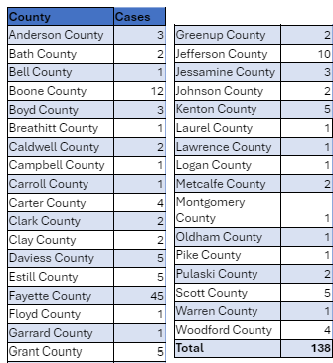34 counties have had cases of whooping cough this year; health department says highest level of infection since 2016-17

By Melissa Patrick
Kentucky Health News
In about a month, cases of whooping cough in Kentucky increased nearly 82%, indicating an elevated rate of infection, according to the state Department for Public Health.
On July 19, DPH reported 138 cases of whooping cough, known medically as pertussis, in Kentucky this year, On June 14, Kentucky Health News reported there had been 76 cases in 2024.
 |
| 2024 pertussis cases by county (Table by state Department for Public Health) |
DPH says this level of infection has not been seen in Kentucky since 2016-17 when when 463 and 449 cases were reported, respectively.
“Anyone can get pertussis, though infants are at greatest risk for life-threatening illness,” Dr. Steven Stack, DPH commissioner, said in a news release. “Fortunately, vaccinations are available to help prevent serious disease.”
Whooping cough is a highly contagious respiratory illness spread by coughing and sneezing. Infected people can spread the disease from the start of symptoms and at least two weeks after coughing begins.
Early symptoms of whooping cough look like a common cold, including runny nose, sneezing, mild cough and low-grade fever. After one to two weeks, long coughing spells develop, which often occur in explosive bursts, sometimes ending with a high-pitched whoop and vomiting. This can go on for up to 10 weeks or more, according to the Centers for Disease Control and Prevention.
Babies younger than one year old are at greatest risk of getting whooping cough and having severe complications from it. And people with pre-existing health conditions that may be worsened by whooping cough are at high risk for developing a severe infection.
The best way to prevent whooping cough is through vaccination. The childhood vaccine is called DTaP. Infants should receive a series of DTaP immunizations at 2, 4, and 6 months, with boosters at 15-18 months and 4-6 years. Children should then get a single dose of the booster, called Tdap, at 11 or 12. Boosters are required every 10 years to maintain efficacy.